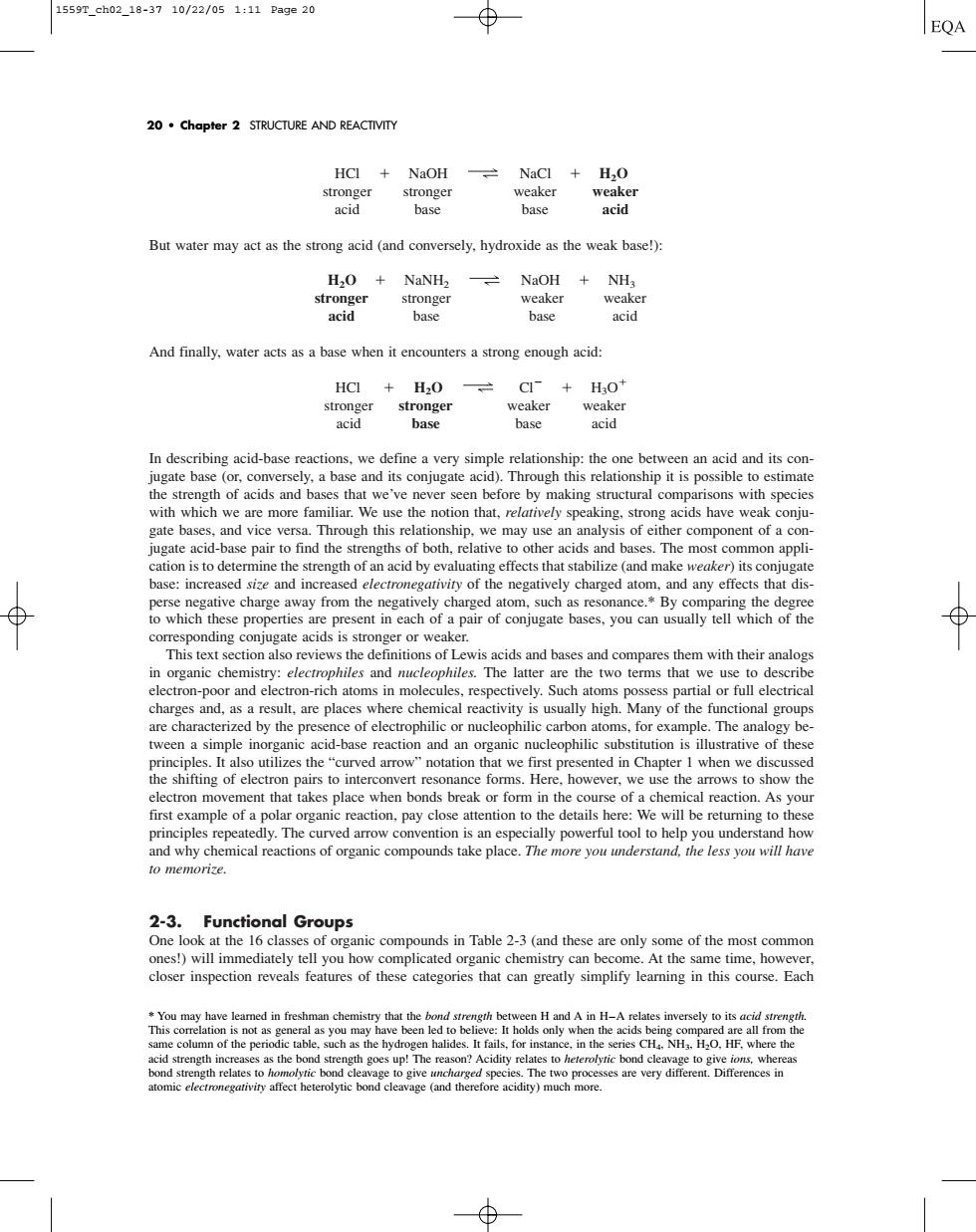正在加载图片...

1559reh0218-3710/22/051:11Page20 EQA 20.chapter 2 STRUCTURE AND REACTIVITY HCI NaOH ce But water may act as the strong acid (and conversely,hydroxide as the weak base!) H2O NaNH2 stronge And finally,water acts as a base when it encounters a strong enough acid: weaker weake base acid In describing acid-base reactions.we define a very simple relationship:the one between an acid and its con and its conjugate acid)Th ougn this re with which we are more familiar.We use the notion that.speaking.strong acids have weak coniu nalysi s of either component of a c base:increased size and increased of the negatively charged atom,and any effects that dis e or weake This text secu n also revie s of cids and base andcompares them with sess panial or full electrical charges and,as a result,are places w e ucleophilic tion is of thes e the cured awotaic eit prsented in Chapicr I when we dicu rs t ver.we use the arro nt t first example of apolar reaction pay close attention to the details here:We will be retuming to thes to memorize. 2-3.Functiongl Gr One look at the 16 classes of organic compounds in Table 2-3(and these are only some of the most common may have eamed that the H and A in H-A relate versely to its ach as t he hy in th e thHCl NaOH NaCl H2O stronger stronger weaker weaker acid base base acid But water may act as the strong acid (and conversely, hydroxide as the weak base!): H2O NaNH2 NaOH NH3 stronger stronger weaker weaker acid base base acid And finally, water acts as a base when it encounters a strong enough acid: HCl H2O Cl H3O stronger stronger weaker weaker acid base base acid In describing acid-base reactions, we define a very simple relationship: the one between an acid and its conjugate base (or, conversely, a base and its conjugate acid). Through this relationship it is possible to estimate the strength of acids and bases that we’ve never seen before by making structural comparisons with species with which we are more familiar. We use the notion that, relatively speaking, strong acids have weak conjugate bases, and vice versa. Through this relationship, we may use an analysis of either component of a conjugate acid-base pair to find the strengths of both, relative to other acids and bases. The most common application is to determine the strength of an acid by evaluating effects that stabilize (and make weaker) its conjugate base: increased size and increased electronegativity of the negatively charged atom, and any effects that disperse negative charge away from the negatively charged atom, such as resonance.* By comparing the degree to which these properties are present in each of a pair of conjugate bases, you can usually tell which of the corresponding conjugate acids is stronger or weaker. This text section also reviews the definitions of Lewis acids and bases and compares them with their analogs in organic chemistry: electrophiles and nucleophiles. The latter are the two terms that we use to describe electron-poor and electron-rich atoms in molecules, respectively. Such atoms possess partial or full electrical charges and, as a result, are places where chemical reactivity is usually high. Many of the functional groups are characterized by the presence of electrophilic or nucleophilic carbon atoms, for example. The analogy between a simple inorganic acid-base reaction and an organic nucleophilic substitution is illustrative of these principles. It also utilizes the “curved arrow” notation that we first presented in Chapter 1 when we discussed the shifting of electron pairs to interconvert resonance forms. Here, however, we use the arrows to show the electron movement that takes place when bonds break or form in the course of a chemical reaction. As your first example of a polar organic reaction, pay close attention to the details here: We will be returning to these principles repeatedly. The curved arrow convention is an especially powerful tool to help you understand how and why chemical reactions of organic compounds take place. The more you understand, the less you will have to memorize. 2-3. Functional Groups One look at the 16 classes of organic compounds in Table 2-3 (and these are only some of the most common ones!) will immediately tell you how complicated organic chemistry can become. At the same time, however, closer inspection reveals features of these categories that can greatly simplify learning in this course. Each 20 • Chapter 2 STRUCTURE AND REACTIVITY * You may have learned in freshman chemistry that the bond strength between H and A in H–A relates inversely to its acid strength. This correlation is not as general as you may have been led to believe: It holds only when the acids being compared are all from the same column of the periodic table, such as the hydrogen halides. It fails, for instance, in the series CH4, NH3, H2O, HF, where the acid strength increases as the bond strength goes up! The reason? Acidity relates to heterolytic bond cleavage to give ions, whereas bond strength relates to homolytic bond cleavage to give uncharged species. The two processes are very different. Differences in atomic electronegativity affect heterolytic bond cleavage (and therefore acidity) much more. 1559T_ch02_18-37 10/22/05 1:11 Page 20